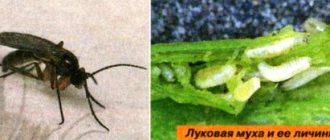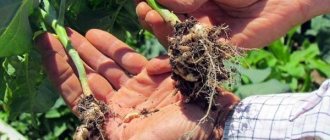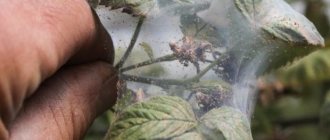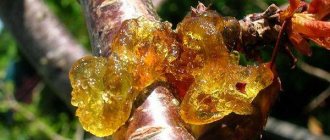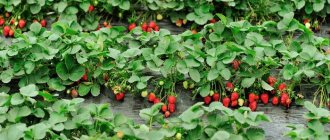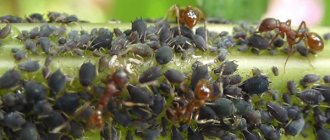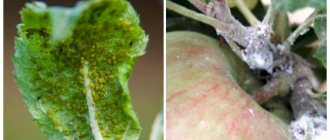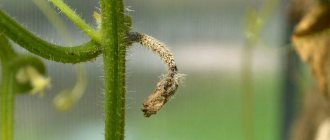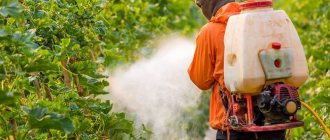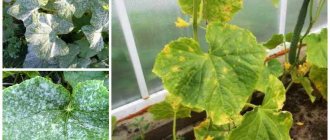Description of the pest
The body of the insect is 6–10 mm long and gray with a greenish tint on the back. The pest has black legs and transparent wings.
On the abdomen of males, unlike females, there is a dark longitudinal stripe. Their eyes are located close together, and in females they are separated by the forehead.
The body of the larvae is white, cylindrical, up to 10 mm long. The larva has no distinct head and no legs. The body is narrowed towards the anterior end; a black mouth opening is located here. The abdomen is sloping at the back, and 16 conical tubercles are visible on the anal area. The larvae retain these tubercles when they develop into shiny red-brown pupae (puparia).
The pest lays white eggs, 1–2 mm in size, pointed at one end and blunt at the other.
Signs of insect damage to onions
There is no need for special instructions for detecting malicious larvae. They are quite clearly indicated by a putrid odor, deformed, unpleasantly soft bulbs, putrid coating, curled and yellowed feathers.
When stored in a warehouse or cellar, they quickly rot. They are not suitable for food, and it is unsafe due to the spread of putrefactive bacteria.
In the bulb you can find not only larvae - whitish worms with a colorless transverse stripe, but also pupae that clearly resemble oblong barrels of a brownish-brick color.
This is a sign that the infestation has already reached a significant extent, although this is unusual because the larvae pupate primarily in the soil.
Life cycle
The full development cycle lasts 45–80 days and goes through 4 stages: egg, larva, pupa, imago (adult). The pest appears in late April - mid-May during the flowering of lilac and cherry trees. At this time, the bow already has 2-3 feathers. Mating occurs immediately after departure and within a week the females lay their first eggs.
On lumps of earth, around the base of leaves or under dry scales of bulbs, they leave heaps of 5–20 eggs for 2 weeks. Females are fertile, capable of laying 60–200 eggs . The embryo in the egg develops in 3–8 days. The emerging larvae are voracious and quickly bore into the bulbs. In search of food they can move from one plant to another.
The pest remains in the larval phase for 15–20 days. During this time, 4–5 molts occur. As the larvae grow, the upper skin does not stretch much, so the pest sheds it several times.
The time intervals between molts are called instars, each of them lasts 3–4 days. Immediately after molting, the larva's body is tender and vulnerable. The development of larvae is affected by air temperature. The higher it is, the faster this process occurs.
After the last molt, the larvae enter the pupal stage. This is the transitional stage of a larva into an adult insect. Pupation occurs in the ground under plants at a depth of 3–7 cm. The pupae are motionless, but a serious restructuring is taking place in their body.
After 2–3 weeks, the fully formed adult fly breaks through the cocoon, comes out and spreads its wings. He does not leave his place immediately, but as soon as his body gets stronger. Second generation onion flies appear in July . Adults live 12–30 days; to lay eggs, females gain strength from the nectar of flowers.
The pest overwinters in the pupal stage in the ground at a depth of 10–20 cm. Depending on the climatic region, 1–3 generations of insects appear in just one season .
No. 4. Tobacco
The smell of tobacco reliably repels flying parasites from onion plantings. The space around the plants is dusted with the substance at the rate of a tablespoon per square meter. The operation must be carried out on damp soil, followed by surface loosening.
Advice. If there is not enough tobacco, you can combine it with lime or river sand in a 1:1 ratio. More effective additives are mothballs and hot pepper (also 1:1).
Tobacco infusion is also very helpful in repelling flies. Take 200-250 grams of tobacco crumbs per 10-liter bucket of water, leave for 2 days, filter, add soap and generously spray onion foliage. About a liter of this infusion is consumed per square meter.
The frequency of use of the infusion and powder is at least once every 7-10 days.
It is known that nicotine is released only in an alkaline environment. Therefore, it is important to properly prepare the repellent solution:
Signs of onion infection
Onion fly larvae
The most dangerous thing for plants ; they do the most damage. They penetrate into the pulp of the bulb through the base of the leaves or from the bottom. They gnaw out large areas, forming passages .
In onions, larvae from one oviposition usually feed on one bulb; in onion sets, they move to neighboring ones and eat away large cavities in the head. With a severe infection, more than 50 larvae can colonize the bulb. The larvae of the first generation destroy early varieties in June, the second - plants in July-August.
In the garden, at the first sign, it is noticeable that the plants are targeted. The feathers of such an onion turn yellow, wither and fold in half, and then dry out . If the plant is pulled out of the ground, you will see that the bulb has softened, is covered with a coating of mold, and the bottom is occupied by small white worms . Damage allows fungal infections to enter the tissue. Infected bulbs rot, and in wet weather this happens faster and smells unpleasant.
In addition to onions, the pest colonizes garlic if it is grown continuously for several years in the same place. The onion fly damages tulip bulbs , as well as carnations, delphiniums, and phlox .
No. 11. Kerosene
A fly will fly past your onions if you sprinkle the rows with sand “scented” with kerosene every 10-12 days. ½ bucket consumes 200 milliliters of combustible mixture.
An aqueous solution (2-3 tablespoons of kerosene per 10 liters of water) has a similar effect. You can add 100-200 grams of salt to the mixture. By the way, this composition additionally causes the death of onion fly larvae.
Advice. All manipulations with kerosene are carried out with gloves, since the characteristic odor easily eats into the skin and is difficult to wash off.
The first time kerosene is used is in April-May, when the pest has just woken up. Next, 2 more treatments are performed with a break of 10-14 days. But this time salt is no longer added.
Did you know? Kerosene has gained recognition among summer residents as a herbicide. But it is absolutely safe for onions and does not cause damage to the crop.
Reasons for the appearance of the pest on the site
The onion fly prefers loam and sandy loam soils, and is less common on peat bogs. Loves beds fertilized with fresh manure.
The pest settles in areas where onions and garlic have been continuously grown for many years. The problem is aggravated by the lack of autumn tillage. Since the pupae remain in the ground for the winter, pre-winter deep digging will help destroy some of the larvae that are on the soil surface.
The number of pests is affected by weather conditions. With sharp spring warming, the activity of onion flour increases. In a wet, cold spring, the harmfulness is reduced, since adult individuals appear later, egg laying and the appearance of larvae are delayed.
The pest may appear on the site when planting onion sets that are infected or not pre-treated.
Signs of the presence of a pest in the garden
It is difficult to see the larvae, since they do not crawl to the surface of the soil unless absolutely necessary. But from the appearance of the plants, it is immediately clear what kind of pest has attacked your garden: the plants develop unusually slowly, their feathers turn yellow and wither, and they also begin to smell disgusting. The bulbs become soft and loose to the touch, and a rotten coating is noted. They cannot be eaten.
How to get rid of onion fly
Chemical and biological drugs
Strong chemicals will be needed when the pest appears en masse and over large areas. The onion fly damages plants both in open ground and in greenhouses. If you notice it in time, you can do without chemicals or immediately destroy the affected specimens.
In the larval phase, chemicals penetrate well into the delicate skin of the pest. At this stage, contact treatments will be effective. But processed vegetables are only suitable for eating after 2–3 weeks. It is not recommended to spray onion feathers with chemicals.
Aktara VDG
Plants are sprayed against onion flies with a solution prepared from 4 g of the drug and 10 liters of water. The granules are dissolved in warm water (temperature should not be lower than 25°C).
This volume is designed to process 10 square meters. m. The onions are sprayed for the first time when the dandelions begin to bloom, and after 1–1.5 months the plants are sprayed again.
Alatar CE
The dosage of the drug for pest control is 5 ml per 4 liters of water. The beds with onions and garlic are processed in the morning or evening in dry weather no more than 2 times per season.
Corado
Systemic drug for the destruction of adult onion flies and their larvae. Does not lose its properties in dry hot weather and is not washed off by rain.
The onions are processed for the first time before planting. The seedlings are sprayed with a solution prepared from 15 ml of the drug and 0.2 liters of water. This volume is consumed for 10 kg of sets.
The onion is sprayed a second time when 3-4 feathers grow. The concentration of the drug is 2 ml per 2 liters of water. The solution consumption is 1 liter per 1 hundred square meters.
Summer resident
Biological preparation from Siberian fir extract. Harmless to humans, animals, bees, does not pollute the soil. It is used for spraying.
5 ml of the product is diluted in 8 liters of water. The solution does not lose its properties in cool and rainy weather. But a one-time treatment will not give results. Onions will need to be sprayed at least 3 times.
ExtraFlor
A preparation based on tobacco extract to protect plants from many insect pests, including onion flies. Helps to grow environmentally friendly and healthy vegetables. The contents of the package (1 g) are poured into 1 liter of warm water, mixed and the liquid is allowed to cool. Before use, the solution is filtered.
Fly eater
Diazinon-based insecticide for killing adult flies and their larvae in the soil. For pest control, it is used once before planting onions.
In calm, dry weather, granules are scattered over the soil surface at the rate of 50 g per 10 square meters. m. Then the beds are loosened. Pests die within 2–3 days after the drug enters their body. The protective effect lasts 2 months.
Zemlin
Preparation for soil application. It is scattered over the top layer and at the same time loosened the ground. The consumption rate of the product is 3 g per 1 sq. m. It protects against onion flies for 20 days.
Sochva J
The drug repels the onion fly and does not allow it to settle in the treated area. It is produced in liquid form, it is a concentrate of wood smoke. When using a concentrate, plants are less damaged - by 50%-90%.
5 ml of the drug is mixed with 1.5 liters of water and sprayed onion feathers 2-3 times. The break between treatments is 7 days. The consumption rate of the working solution is 5 liters per 1 sq.m.
Traditional methods
- Onion flies, which appear in the spring, are inactive, fly slowly and sometimes get indoors. If the planting area is small, they can be easily caught by hand or with a net.
- The onion fly is sensitive to odors. To protect plants, solutions are prepared from fragrant herbs, ash, and ammonia. These methods will be effective if applied systematically and immediately after planting the onions.
- Tobacco in its pure form or mixed with ash and ground pepper is scattered along the rows (1–2 kg per 10 sq. m.), and then the soil is loosened. Solutions for spraying are prepared from tomato tops, wormwood, and chamomile. You can place the chopped stems of these plants in the rows. After a week, the wilted tops are replaced with fresh ones.
- The insect cannot stand the smell of tar. Before planting, the bulbs are soaked for 2 hours in a tar solution: 10 g are dissolved in 1 liter of water. The tar smell when spraying onion leaves will repel insects. The crop is treated during the egg laying period. The solution is prepared from 20 g of tar and 10 liters of water. The procedure is carried out 2-3 times with a break of 10-14 days.
- Water the damp soil with a solution of ammonia. 1–2 tbsp. l mixed with 10 l of water. The nitrogen contained in the solution will feed weakened plants and prevent yellowing of the feather tips.
- An old way to combat the pest is to water the soil with saline solution. 200 g of table salt are dissolved in 10 liters of water. The solution is used only on moistened beds. After treatment, they are watered again with clean water. The saline solution is used once per season. They cannot constantly cultivate the soil, otherwise salinization cannot be avoided.
Preventive measures
To prevent the occurrence of the pest, it is necessary to take appropriate measures in a timely manner.
Digging
Digging up the land will help get rid of the pest. Most often, insect pupae are stored in the soil; when digging in the autumn, the soil is disinfected with the help of frost.
Important. The onion fly reproduces quickly. She can lay eggs up to three times during the season.
Boarding time
Choose the right time to plant onions. All varieties of vegetables must be planted in the soil as early as possible, after it has warmed up to the required degree. Onions tolerate low temperatures well, and light frosts will be an additional method of pest control. Autumn is the right time to prepare the site for sowing, so it is necessary to remove all old leaves that may contain larvae.
High-quality planting material
The material for planting onions must be selected very carefully. You should not purchase onions from unverified places. The planting material may contain pest eggs, which, once in the soil, will begin to develop and after a few weeks will appear as a swarm of onion flies. Before planting, it is necessary to treat the seeds with a manganese solution.
Selecting a location
When planting onions, you need to pay great attention to the location of the site. The bed should be in a ventilated place with sufficient sunlight. Also, the crop planting site should not be in places with high humidity, which can lead to the appearance of diseases and pests.
Inta-Vir
The popular and inexpensive insecticide Inta-Vir is moderately toxic and is successfully used by gardeners to combat onion flies. The solution is prepared at the rate of one tablet per 10 liters of water, it is used immediately after preparation. You can treat the beds with a regular watering can or with a spray bottle. Repeated treatment is allowed no earlier than 14 days. You should not eat vegetables for the same amount of time after using the drug. You can do no more than three treatments per season.
Inta-Vir is a popular insecticide with moderate toxicity, successfully used to control onion flies
Alatar
This product destroys almost all pests of garden and garden crops, including onion flies. The inclusion of two active poisons in Alatar provides the drug with a combined mechanism of action on the pest’s body, resulting in high mortality of its large-scale colonies. Alatar can be used twice, maintaining an interval of 10 days between treatments. The drug is used very rarely more than twice. The waiting period is 3 weeks. To prepare a working solution, 5 ml of the drug is diluted in 4 liters of water, this amount is enough to treat 100 m2. Alatar is not washed off by rainwater, and is also resistant to ultraviolet rays and high air temperatures.
Alatar contains two active poisons, which makes the drug highly effective against most pests
Creolin
Reviews about the effectiveness of this drug in the fight against onion flies are positive, even enthusiastic. However, Creolin is recommended to be used as a last resort when other methods do not give the desired result, since the product is very toxic. The drug is a viscous liquid with a pronounced pungent odor and consists of naphthalene, coal oil, and ichthyol. It is used by veterinarians as an antiparasitic agent.
Creolin is very toxic, so it is used with great caution
The instructions for creolin, sold in pharmacies, contain compositions for treating animals and premises against ticks and other parasites. Creolin is not on the list of approved drugs, but it is included in many pesticides. The most common dosage option in sources is 2 tablespoons per 10 liters of water. The first treatment can be carried out when the onion feathers reach a length of 8–10 cm, and repeated treatment after three weeks.
Crop rotation rules
To reduce the risk of pest occurrence, it is necessary to follow the basic rules of crop rotation; onions should not be planted in one area for several years; it is necessary to regularly change crop planting sites.
Also, onions are not planted in places where crops that had the same pests as onions previously grew.
Neighborhood with carrots
Proximity to carrots can protect onions from fly infection. Carrots repel the pest and do not affect the development and yield of onions. It is recommended to alternate onion beds with carrot beds.
Proper watering
Onions need to be watered as the soil dries out; excessive moisture can provoke the formation of rot on the bulbs. Weakened plants are susceptible to pest attacks.
In order to properly water the plant, it is necessary to use watering cans to distribute the liquid evenly, and moistening is carried out until the end of June, after which it stops.
Is it true that the onion fly does not like the smell of carrots, but onions repel the carrot fly?
Planting these vegetables together repels pests. The onion fly does not like the smell of carrots, and onion phytoncides repel the carrot fly. When planting together, you need to take into account that onions ripen earlier and 2 weeks before harvesting they stop watering them so that the bulbs ripen in dry soil. Carrots still need a lot of moisture at this time. Therefore, it is better to plant crops without alternating rows, but by dividing the bed lengthwise into 2 parts . On one side, onions are planted, and on the other, carrots.
How to prevent the reappearance of pests?
To prevent insects from settling in your house or apartment again, you need to take measures to repel them. Thus, onion midges cannot tolerate the smell of pine needles and basil. Therefore, you need to purchase essential oils of fir, pine, and basil, soak cotton wool in them and place them in places where vegetables are stored.
Insects do not like the smell of clove seasoning - it can be stuck into citrus fruits that are stored outside the refrigerator. Midges also react negatively to the aromas of ylang-ylang, patchouli, and verbena oils, so they can be dripped into aroma lamps and used regularly. Midges also cannot stand the smell of camphor, which, by the way, is absolutely not harmful to humans. Preventing the appearance of midges is not difficult, but it is effective, and an unpleasant neighborhood will most likely not happen to them.
Prevention
- Maintaining crop rotation. The onion is returned to its original place no earlier than after 3 years.
- Planting and sowing early so that the onion has time to get stronger by the time the insect flies. The planting material is pre-etched. To speed up the growth of the heads, at the end of May the plants are fed with urea.
- The soil around the crops is mulched with compost, peat or a mixture of them with crushed coniferous or pine litter. Loose soil makes it more difficult for insects to lay eggs.
- At the first sign of a pest, infected bulbs are pulled out and destroyed.
- In autumn, plant debris is removed from the site, and the soil is dug up deeply.
These measures will not give the pest the opportunity to take over the site and will help to grow onions healthy and without losses.
More details: you will learn how to deal with onion flies from the video.
Methods of pest control and preventive measures
You should decide right away: once the larvae appear, it is practically useless to fight them. It is necessary to prevent the appearance of onion flies in onion plantings. Then egg laying will not occur. Therefore, it is recommended to start with the simplest. Prevention measures are not particularly difficult, but are quite effective:
- autumn digging of the soil on the site will raise the pupae to the top, and they will be destroyed by frost;
- onions need to be planted as early as possible, they will tolerate relatively low temperatures, but pupae will not;
- before sowing, it is advisable to remove old leaves and debris; pupae or even onion fly larvae may also be hiding there;
- There may also be pest eggs in the planting material; onion sets must be carefully sorted before planting;
- the seeds must be completely disinfected with a solution of potassium permanganate;
- It is recommended to take a responsible approach to choosing a planting site: the bed should be well lit and actively ventilated;
- you cannot choose wet areas, some pest will always appear there;
- It is not recommended to plant onions in a place where other bulbs or legumes grew last year;
- Carrots growing nearby repel onion flies well.
Watering is of great importance. It should not be produced too abundantly, otherwise the onion fly will choose a place to lay eggs there. In addition, the roots begin to rot, which also attracts pests. Too dry soil will cause the plant to wilt. Knowing how to get rid of onion flies, you can use folk remedies. Their main advantage is the lack of toxicity.
How to treat plants against onion fly?
To protect against onion flies on large plantations, where there is simply nothing to do with folk remedies, modern and approved insecticides are used. For example, neonicotinoids, Thiamethoxam and Imidacloprid, as well as organophosphorus compounds, Diazinon and Dimethoate, have gained popularity. Pyrethroids such as Stomazin, Ripcord, Cypermethrin, Stomoxin and Baytikol have also proven themselves well in the fight against onion flies.
These drugs are used in liquid form, dissolved in water, and are used to combat onion flies by spraying. When using these medications, you must strictly follow the instructions on the packages. The active substances of these drugs specifically affect adult insects, causing their death.
For those who do not accept the use of chemicals on their plots, we can recommend one of the alternative methods of combating onion flies, which we will now discuss.
Signs of damage to onions by onion flies. © digginwivdebb
